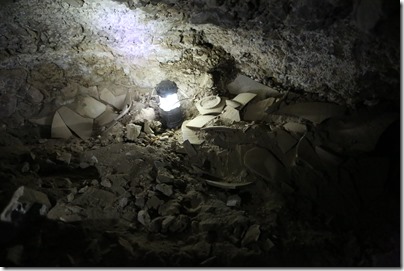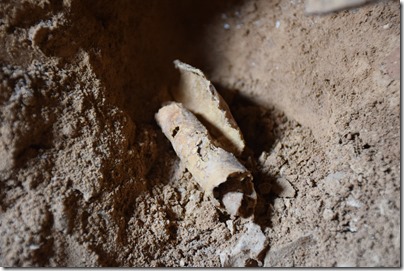Archaeologists have discovered a cave on the cliffs above Qumran that held Dead Sea Scrolls until it was looted in the mid-1900s. Eleven caves have previously been identified containing ancient scrolls, but no new ones have been discovered since Cave 11 was found in 1956.
From the Hebrew University press release:
Excavation of the cave revealed that at one time it contained Dead Sea scrolls. Numerous storage jars and lids from the Second Temple period were found hidden in niches along the walls of the cave and deep inside a long tunnel at its rear. The jars were all broken and their contents removed, and the discovery towards the end of the excavation of a pair of iron pickaxe heads from the 1950s (stored within the tunnel for later use) proves the cave was looted.
Until now, it was believed that only 11 caves had contained scrolls. With the discovery of this cave, scholars have now suggested that it would be numbered as Cave 12. Like Cave 8, in which scroll jars but no scrolls were found, this cave will receive the designation Q12 (the Q=Qumran standing in front of the number to indicate no scrolls were found).
“This exciting excavation is the closest we’ve come to discovering new Dead Sea scrolls in 60 years. Until now, it was accepted that Dead Sea scrolls were found only in 11 caves at Qumran, but now there is no doubt that this is the 12th cave,” said Dr. Oren Gutfeld, an archaeologist at the Hebrew University’s Institute of Archaeology and director of the excavation. “Although at the end of the day no scroll was found, and instead we ‘only’ found a piece of parchment rolled up in a jug that was being processed for writing, the findings indicate beyond any doubt that the cave contained scrolls that were stolen. The findings include the jars in which the scrolls and their covering were hidden, a leather strap for binding the scroll, a cloth that wrapped the scrolls, tendons and pieces of skin connecting fragments, and more.”
The finds from the excavation include not only the storage jars, which held the scrolls, but also fragments of scroll wrappings, a string that tied the scrolls, and a piece of worked leather that was a part of a scroll. The finding of pottery and of numerous flint blades, arrowheads, and a decorated stamp seal made of carnelian, a semi-precious stone, also revealed that this cave was used in the Chalcolithic and the Neolithic periods.
The press release includes the photos shown below, all courtesy of Casey L. Olson and Oren Gutfeld.
The story is covered by the Jerusalem Post, Haaretz, and The Times of Israel (briefly).




5 thoughts on “Cave 12 Discovered at Qumran”
Wow! This is exciting!
Hi Todd, In my opinion, the find spot for the Dead Sea Scrolls is largely unknown. They photographed the Copper Scroll "in situ," and it is in the museum in Amman. I do not know of another scroll that was found in situ. Do you? They are saying that Dead Sea Scrolls obviously came out of Cave 12, yet none are named from Cave 12. I think that the Biblical scholars for the most part just guessed which cave the scrolls were from, or went by what the Bedouins told them. There is a made up history of the Dead Sea Scrolls which has never set well with me because it gives the impression that the Dead Sea Scrolls were excavated by archaeologists and found in the land of modern day Israel and both are simply not the case. Thank you for everything that you do. With Much Gratitude and Admiration, Sincerely yours, Michael Welch
Hi Michael – thank you for the comment. It's true that some of the caves were discovered and pillaged by Bedouin before archaeologists arrived. But not all. I'm away from my library right now, but this info seems confirmed by the Wikipedia article (which says that the ASOR teams discovered Caves 3-6). In terms of percentage of manuscripts, it may well be that the majority were purchased and not excavated.
Hi Todd, In my opinion you nailed it when you said: "In terms of percentage of manuscripts, it may well be that the majority were purchased and not excavated." The archaeologists did find fragments in the caves, but out of at least 15,000 Dead Sea Scroll fragments, it appears that the numbers which they found were small with "30 or so found in this cave or that cave." The Biblical scholars and archaeologists should simply get the credit they are due for purchasing entire Dead Sea Scrolls and the many fragments. It took lots of money and hard work in the 1940s and 1950s to accomplish this. It was definitely not an easy task! Why not simply say that the majority of the Dead Sea Scrolls were purchased from the Bedouin. Thank you for responding so quickly, and thank you for all of your excellent contributions and your staff's contributions to our knowledge of Biblical related matters. With Much Gratitude and Admiration, Michael
(2/21/2017) Dr. Ronald Stewart, Th.D., Ph.D.
Qumran Cave # 12, Are There Unknown Discoveries?-Part-1-(Discovered (2) Scribes & (2) Jars)
Video-Explanation/Description- The recently discovered Qumran Cave # 12 a piece of (DSS)-(Dead Sea Scroll) parchment (that was not written on, broken jars/ shards were discovered and a small: "Seal" made of carnelian stone. Could there still be: "unknown discoveries" that await re-discovery?
Distinguished Archaeologists Drs. Oren Gutfeld, Ahiad Ovadia, and Dr. Randall Price are to be applauded for their discoveries in cave # 12 at Qumran. For these archaeologists and their teams worked hard to investigate and excavate this cave. However, no archaeologist (or person for that matter); "cannot discover what they cannot see". An imaging technology named (IMMI)-(Infinite Microscopic-Macroscopic Imaging) technology) has an archaeological application. That's able to reveal "hidden indistinguishable detail that cannot be seen with the naked human eye on archaeological artifacts. Like; ancient jar and/or pottery shards, that have faded over time. Dr. Ronald Stewart, Th.D. Ph.D. was able to take the photograph of this small: "Seal" made of carnelian stone". And was able to reveal two possible ancient scribes and intact jars on this seal. That is consistent with the other broken jar shards, and more!
https://youtu.be/YFoF4xiet9k
===================================================
* Qumran Cave # 12, Are There Unknown Discoveries?-Part-2-(Discovered (2) Scribes & (2) Jars)
Video-Explanation/Description- The This is a look at the inside of the: "Dead Sea Scroll Cave # 12. In the upper right middle part of this photo (to the righyt of the bright lantern are
a number of broken jar/pottery shards. That at one time may have held some of today's: "Dead Sea Scroll" Collection. However, could these pottery shards and a rectangular flat surface smooth stone reveal even more: " Unknown Discoveries" in Qumran's (DSS)-(Dead Sea Scroll) Cave # 12? Part # 2 of this video examines these possibilities.
https://youtu.be/ODOUoNDLFYc